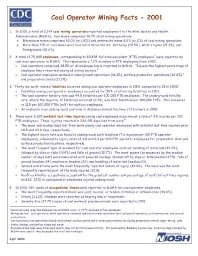Mining Publication: Coal Operator Mining Facts - 2001
Original creation date: April 2003
Authors: National Institute for Occupational Safety and Health
NIOSHTIC2 Number: 20022599
Pittsburgh, PA, NIOSH Publication No. 2003-129, 2003 Apr; :1-2
In 2001, a total of 2,144 coal mining operations reported employment to the Mine Safety and Health Administration (MSHA). Coal mines comprised 14.7% of all mining operations. Bituminous mines comprised 92.0% (n=1,972) and anthracite mines 8.0% (n=172) of coal mining operations. More than 71% of coal mines were located in three states: Kentucky (29.5%), West Virginia (21.3%), and Pennsylvania (20.6%). A total of 75,845 employees, corresponding to 80,858 full-time equivalent (FTE) employees, were reported by coal mine operators to MSHA. This represents a 7.2% increase in FTE employees from 2000. Coal operators comprised 28.8% of all employee hours reported to MSHA. This was the highest percentage of employee hours reported among all mining sectors. Coal operator employees worked in underground operations (46.1%), surface production operations (42.6%), and preparation plants (11.3%). Thirty-six work-related fatalities occurred among coal operator employees in 2001, compared to 28 in 2000. Fatalities among coal operator employees accounted for 50% of all mining fatalities in 2001. The coal operator fatality rate was 44.5 fatalities per 100,000 FTE employees. The underground fatality rate, where the majority of fatalities occurred (n=31), was 83.2 fatalities per 100,000 FTEs. This compares to 11.5 per 100,000 FTEs (n=5) for surface employees. An explosion in an underground coal mine in Alabama claimed the lives of 13 miners in 2001. There were 3,907 nonfatal lost-time injuries among coal employees occurring at a rate of 4.8 injuries per 100 FTE employees. These injuries resulted in 236,451 days lost from work. The mean and median days lost from work among coal operator employees with nonfatal lost-time injuries were 60.5 and 23.0 days, respectively. The highest injury rate was found in underground work locations (7.6 injuries per 100 FTE operator employees), compared to injury rates of 2.8 and 2.3 per 100 FTE operator employees for preparation plant and surface production locations, respectively. The most frequent type of accident for coal operator employees involved handling of materials (33.3%), followed by slips or falls (19.4%) and falls of ground (12.7%). The most severe (as measured by the median number of days lost) were associated with powered haulage (median=29.5), slips or falls (median=27.5), falls of ground (median=24), machinery (median=22), and handling of materials (median=21). Sprains and strains were the most frequently reported nature of injury (43.4%). The back was the most frequently reported part of the body injured (22.8). Roof/rock bolter occupations accounted for the greatest number and percentage of nonfatal lost-time injuries (n=632; 22%) in coal operator employees injured underground. In 2001, 424 cases of occupational illness were reported to MSHA for coal operator employees. The most frequently reported illness was joint, muscle, or tendon irritation or inflammation (39.4%). Ninety (21.2%) illnesses were reported as hearing loss or impairment. Seventy-five (17.7%) cases of coal workers' pneumoconiosis were reported in 2001.

NIOSHTIC2 Number: 20022599
Pittsburgh, PA, NIOSH Publication No. 2003-129, 2003 Apr; :1-2